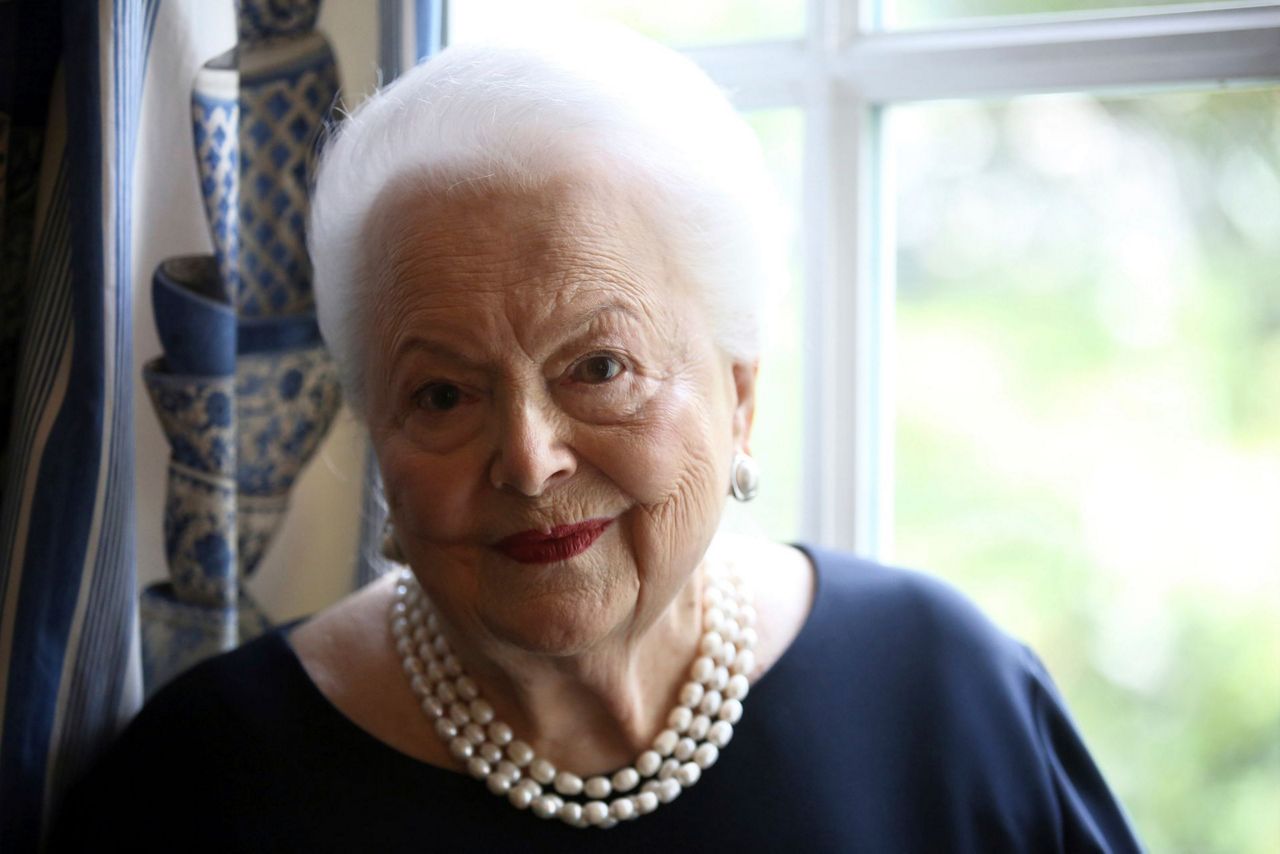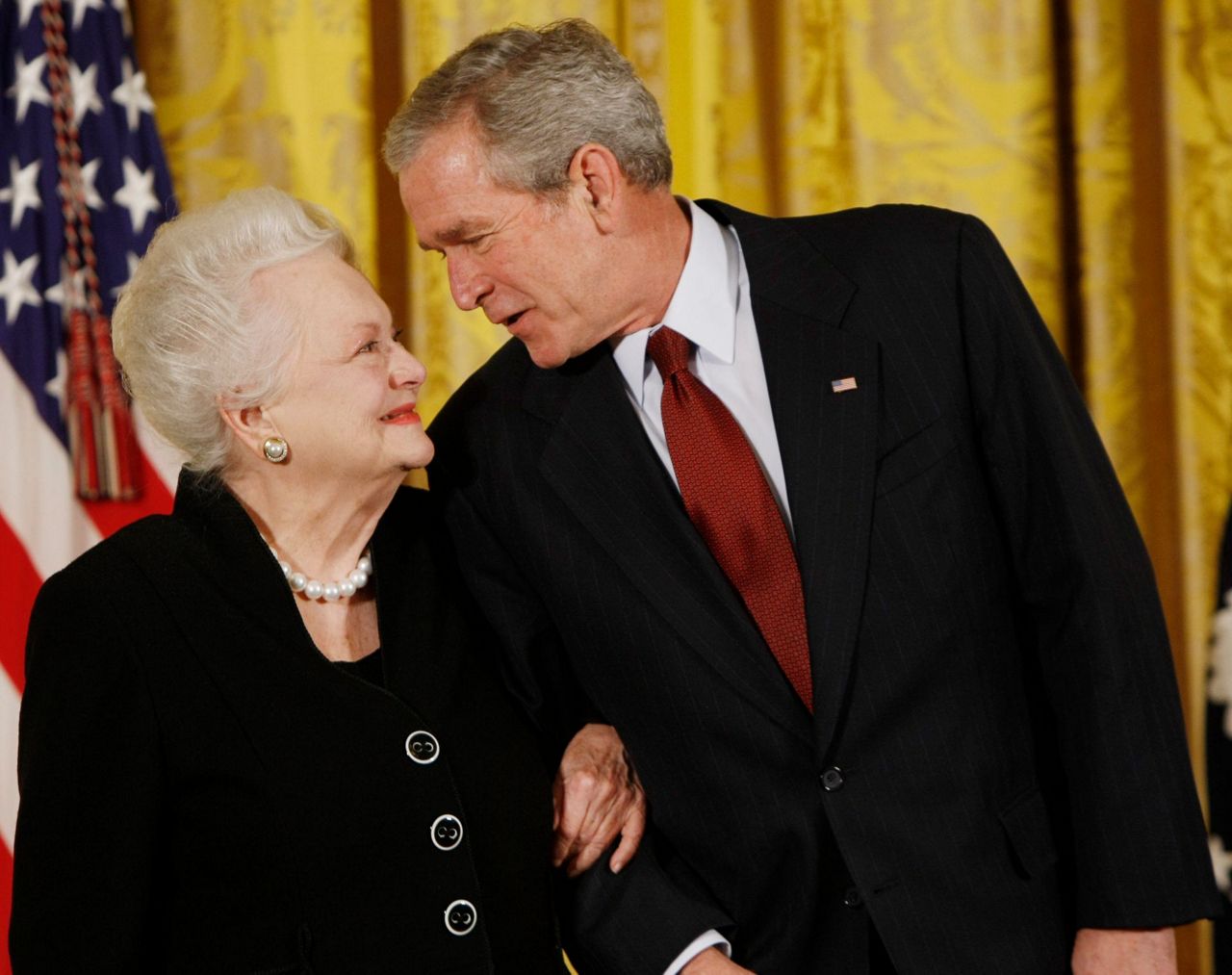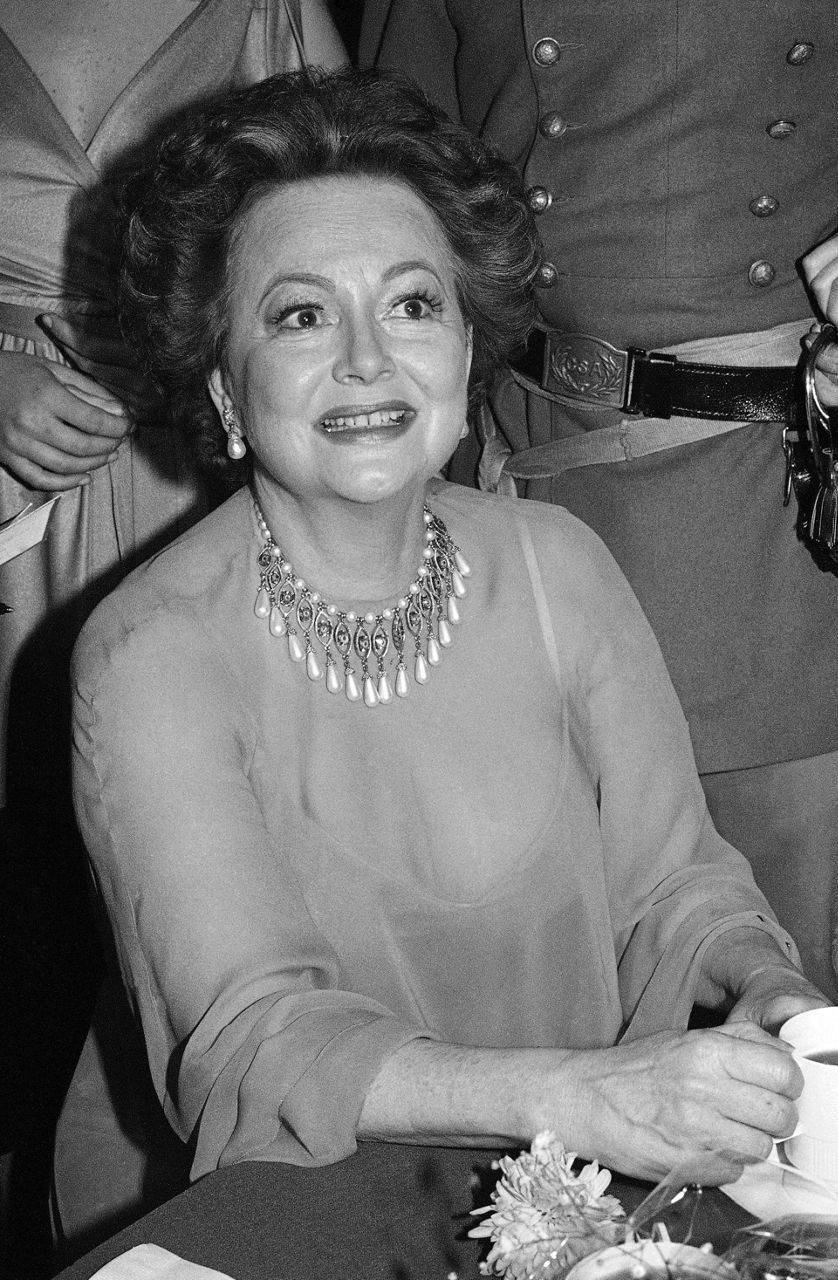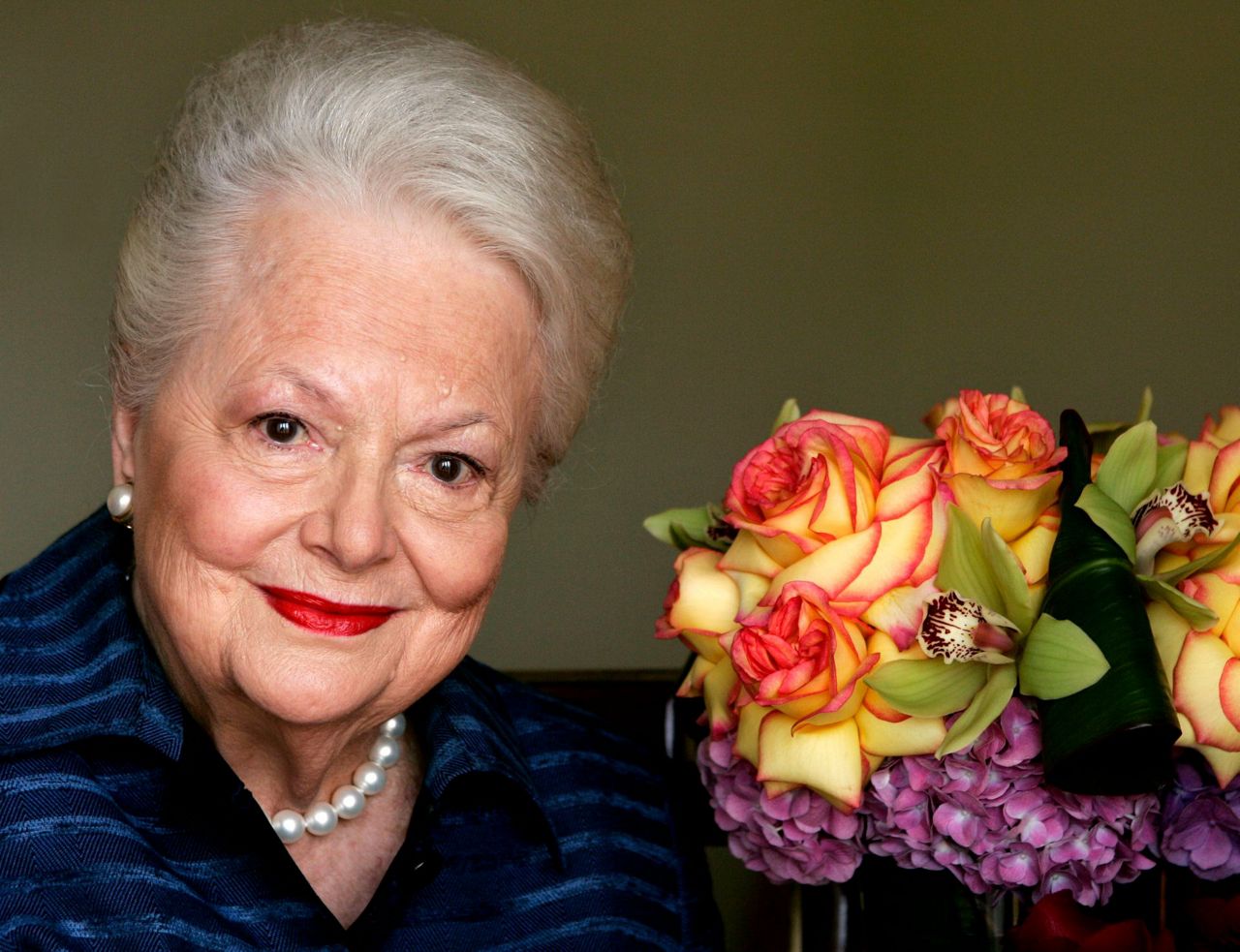NEW YORK (AP) — She was one of Hollywood’s most glamorous stars and determined off-screen fighters. No one was better suited than Olivia de Havilland to play the sainted Melanie Wilkes in “Gone With the Wind” or more tenacious about the right to appear in the films of her choosing.
Fans and actors alike owe much to de Havilland, the Oscar-winning performer who became, almost literally, a law unto herself.
De Havilland, who died Sunday at 104, was one of the last survivors of Hollywood’s so-called Golden Age. She was beloved to millions as Wilkes in “Gone With the Wind, but also won Oscars for “To Each His Own” and “The Heiress” and challenged and unchained Hollywood’s contract system.
De Havilland died peacefully of natural causes at her home in Paris, publicist Lisa Goldberg said.
During a career that spanned more than 70 years, de Havilland was praised in roles ranging from an unwed mother to a psychiatric inmate in “The Snake Pit,” a personal favorite. The doe-eyed actress projected both a gentle, glowing warmth and a sense of resilience and mischief that made her uncommonly appealing, leading critic James Agee to confess he was “vulnerable to Olivia de Havilland in every part of my being except the ulnar nerve.”
The sister of fellow Oscar winner Joan Fontaine, with whom she had one of Hollywood’s most famous sibling rivalries, de Havilland was the last surviving lead from “Gone With the Wind.” The 1939 epic, based on Margaret Mitchell’s best-selling Civil War novel and winner of 10 Academy Awards, is often ranked as the all-time box office champion (adjusting for inflation), but is now widely condemned for its glorified portrait of slavery and antebellum life.
The pinnacle of producer David O. Selznick’s career, “Gone With the Wind” had a dramatic and troubled back story. Three directors worked on the film, stars Vivien Leigh and Clark Gable were far more connected on screen than off and the fourth featured performer, Leslie Howard, was openly indifferent to the role of Ashley Wilkes, Melanie’s husband. But de Havilland, drawn to Melanie’s empathy and generosity, remembered the movie as “one of the happiest experiences I’ve ever had in my life. It was doing something I wanted to do, playing a character I loved and liked.”
She was otherwise known as Errol Flynn’s co-star in a series of dramas, Westerns and period pieces, most memorably as Maid Marian in “The Adventures of Robin Hood.” But de Havilland also was a prototype for an actress too beautiful for her own good, typecast in romantic roles while desiring greater challenges. Her frustration finally led her to sue Warner Bros. in 1943 when the studio tried to keep her under contract after it had expired, claiming she owed six more months because she had been suspended for refusing roles.
Her friend Bette Davis had failed to get out of her contract under similar conditions in the 1930s, but de Havilland prevailed, with the California Court of Appeals ruling that no studio could extend an agreement without the performer’s consent. The decision is still unofficially called the “De Havilland law” and made her as much a pioneer in the entertainment field as baseball star Curt Flood, who took on the game’s “reserve clause” binding players to teams, was in sports.
Fans of “Gone With the Wind” knew of her talent and determination. She was so anxious to play Melanie that she lobbied the wife of studio boss Jack Warner to receive permission to work for Selznick. When Selznick fired director George Cukor and replaced him with Victor Fleming, de Havilland continued to consult privately with Cukor (Leigh did the same). When Gable was reluctant to cry during one of the movie’s most emotional scenes, Melanie comforting Rhett Butler over Scarlett’s miscarriage, de Havilland helped talk him into it and provided unforgettable support on screen.
De Havilland was nominated for an Oscar for “Gone With the Wind” and went on to earn her own Academy Award in 1946 for “To Each His Own,” a melodrama about out-of-wedlock birth. A second Oscar came three years later for “The Heiress,” in which she portrayed a plain homebody (as plain as it was possible to make de Havilland) opposite Montgomery Clift and Sir Ralph Richardson in an adaptation of Henry James’ “Washington Square.” Agee had noted a breakthrough in the 1946 drama “The Dark Mirror,” writing that her performance was “thoughtful, quiet, detailed and well sustained.”
She moved to Paris in 1953, “at the insistence” of her then-husband, Frenchman Pierre Galante, she told The Associated Press in 2016. “Hollywood had become a “dismal, tragic place” and she found no reason to return to the U.S.
“By 1951, television had already made such inroads on the income garnered by motion picture companies that the Golden Era which had prevailed until then was beginning to disintegrate,” she said.
In middle age and after, she appeared in several movies for television, including “Roots” and “Charles and Diana,” in which she portrayed the Queen Mother. She also co-starred with Davis in the macabre camp classic “Hush ... Hush, Sweet Charlotte” and was menaced by a young James Caan in the 1964 chiller “Lady in a Cage,” condemning her tormenter as “one of the many bits of offal produced by the welfare state.” In 2009, she narrated a documentary about Alzheimer’s, “I Remember Better When I Paint.” Catherine Zeta-Jones played de Havilland in the 2017 FX miniseries about Davis and Joan Crawford, but de Havilland objected to being portrayed as a gossip and sued FX. The case was dismissed.
Fitting for one of Hollywood’s most majestic stars, she spent her latter years residing in a town house near the Bois de Boulogne in Paris. One reason she liked Paris was because she could walk down the street without being bothered, at least until “Gone With the Wind” aired on French television.
In 2008, de Havilland received a National Medal of Arts and two years later was awarded France’s Legion of Honor.
She was born in Tokyo on July 1, 1916, the daughter of a British patent attorney, and as an adult openly envied the security she imagined Melanie enjoyed from a happy family life. The actress’ parents separated when she was 3, and her mother brought her and her younger sister Joan, to Saratoga, California. De Havilland’s own two marriages, to Galante and to Marcus Goodrich, ended in divorce. She had a child with each of them.
She is survived by one of those children, daughter Gisele Galante Chulack, along with son-in-law Andrew Chulack and niece Deborah Dozier Potter. Her funeral will be private.
De Havilland had lived in Paris since 1953. In a rare interview with The Associated Press in her luxurious residence there in 2016, as she celebrated her 100th birthday, she said she moved to the City of Light “at the insistence” of Galante, her late French former husband, and found no reason to return to the U.S.
She attributed her longevity to three L’s: “love, laughter, and learning,” and displayed a keen sense of humor — even calling her interviewer a “rascal” for a probing question.
Her acting ambitions dated back to stage performing at Mills College in Oakland, California. While preparing for a school production of “A Midsummer Night’s Dream,” she went to Hollywood to see Max Reinhardt’s rehearsals of the same comedy. She was asked by Reinhardt to read for Hermia’s understudy, stayed with the production through her summer vacation and was given the role in the fall.
Warner Bros. wanted stage actors for their lavish 1934 production and chose de Havilland to co-star with Mickey Rooney, who played Puck.
“I wanted to be a stage actress,” she would recall. “Life sort of made the decision for me.”
By 1935, she had been paired with Flynn in the adventure “Captain Blood” and she worked with him often over the next decade. Well after much of the public had forgotten such releases as “Dodge City” and “Santa Fe Trail,” fans remained obsessed with how well Flynn and de Havilland — one of the screen’s most attractive couples — got along in private life. Flynn was a compulsive womanizer even by Hollywood standards, but de Havilland insisted that her bond with the dashing actor remained, somehow, platonic.
“Oh, Errol had such magnetism! There was nobody who did what he did better than he did,” de Havilland said. “We were lovers together so often on the screen that people could not accept that nothing had happened between us.”
She did date Howard Hughes and James Stewart and had an intense affair in the early ’40s with John Huston. Their relationship led to conflict with Davis, her co-star for the Huston-directed “In This Our Life”; Davis would complain that de Havilland, the supporting actress, was getting more flattering time on camera.
“It was Valentine’s Day on the set,” studio boss Jack Warner later said.
Around the same time, the De Havilland-Fontaine feud became public, a conflict aired by the 1941 Oscar race that placed them in competition for best actress. Fontaine was nominated for the Hitchcock thriller “Suspicion” while de Havilland was cited for “Hold Back the Dawn, a drama co-written by Billy Wilder and starring de Havilland as a school teacher wooed by the unscrupulous Charles Boyer.
Asked by a gossip columnist if they ever fought, de Havilland responded, “Of course, we fight. What two sisters don’t battle?” Like a good Warner Bros. melodrama, their relationship was a juicy narrative of supposed slights and snubs, from de Havilland reportedly refusing to congratulate Fontaine for winning the Oscar to Fontaine making a cutting crack about de Havilland’s poor choice of agents and husbands. In 2016, de Havilland broke a long silence and referred to her sister as a “dragon lady.”
“On my part, it was always loving, but sometimes estranged and, in the later years, severed,” she said, succinctly, to the AP. “Dragon Lady, as I eventually decided to call her, was a brilliant, multi-talented person, but with an astigmatism in her perception of people and events which often caused her to react in an unfair and even injurious way,”
De Havilland once observed that she related to Scarlett O’Hara as a “career woman,” one who knew what she wanted and was determined to have it. But she longed for Melanie’s spirituality and inner balance. She remembered a conversation with Flynn in the mid-1930s, soon after they met. They were on the Warner Bros. lot and Flynn asked de Havilland, just 18 at the time, what her goals were in life.
“And I thought, ‘What an extraordinary question to be asked! Nobody has asked me that ever,’” she told the Academy of Achievement, based in Washington, D.C., in 2006. “And I said, ‘I would like respect for difficult work well done.’ And then I said, ‘Well, what do you want out of life?’ And he said, ‘I want success.’
“And what he meant by that was fame and riches, both of which he certainly did achieve. But when he said it, I thought, ‘But that’s not enough.’”
___
AP correspondents John Leicester and Thomas Adamson in Paris and former AP Writer Dolores Barclay in New York contributed to this report.
Copyright 2020 The Associated Press. All rights reserved. This material may not be published, broadcast, rewritten or redistributed without permission.






